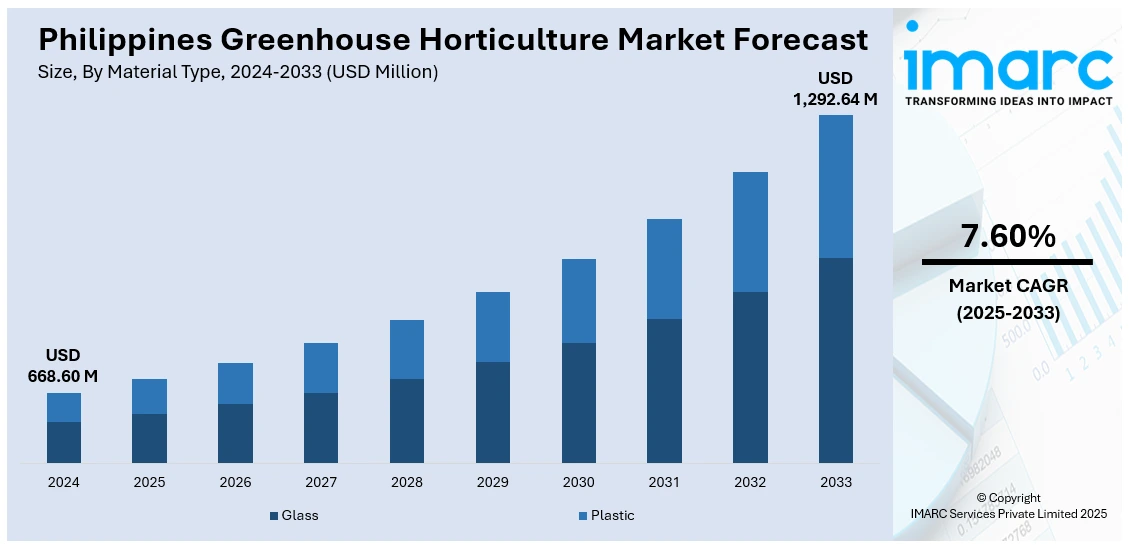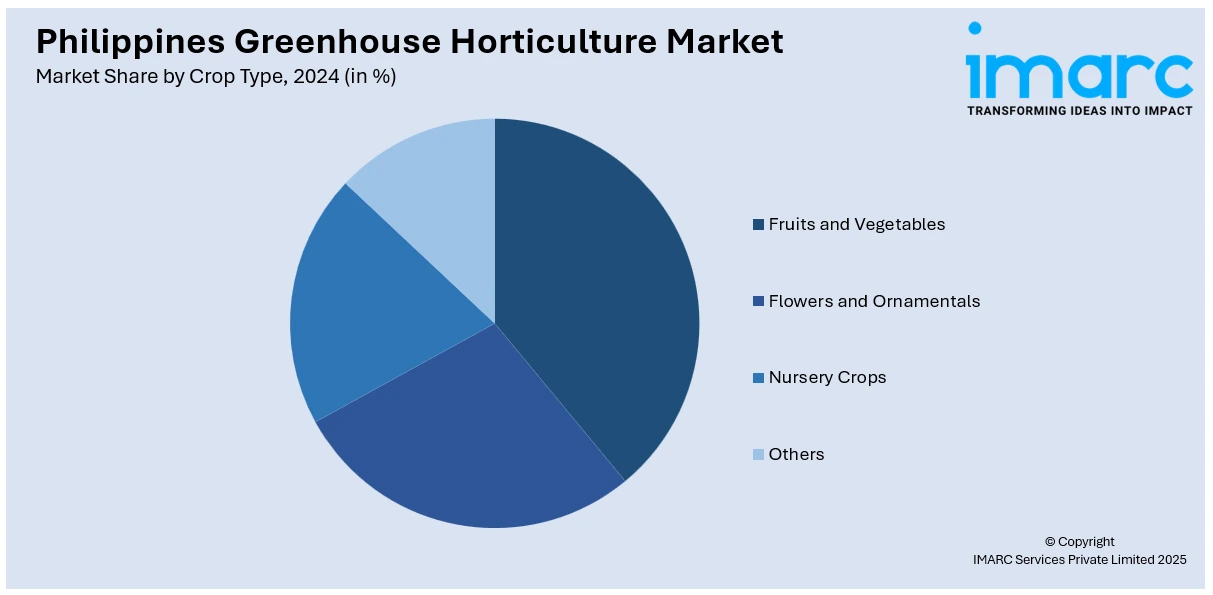
Philippines Greenhouse Horticulture Market Size, Share, Trends and Forecast by Material Type, Crop Type, Technology, and Region, 2025-2033
Philippines Greenhouse Horticulture Market Overview:
The Philippines greenhouse horticulture market size reached USD 668.60 Million in 2024. The market is projected to reach USD 1,292.64 Million by 2033, exhibiting a growth rate (CAGR) of 7.60% during 2025-2033. The market is propelled by the country's rising demand for year-round fresh and high-quality fruits and vegetables, which has encouraged investment in controlled-environment greenhouse horticulture systems. Furthermore, government initiatives and agricultural programs are aimed at modernizing farming practices, promoting sustainable production, and enhancing food security. Apart from this, the growing adoption of advanced technologies enables higher crop yields and reduced dependency on seasonal conditions, thereby augmenting the Philippines greenhouse horticulture market share.
|
Report Attribute
|
Key Statistics
|
|---|---|
|
Base Year
|
2024
|
|
Forecast Years
|
2025-2033
|
|
Historical Years
|
2019-2024
|
| Market Size in 2024 | USD 668.60 Million |
| Market Forecast in 2033 | USD 1,292.64 Million |
| Market Growth Rate 2025-2033 | 7.60% |
Philippines Greenhouse Horticulture Market Trends:
Technological Integration and Smart Greenhouses
The market is witnessing a significant drive toward technological integration, with intelligent greenhouse systems becoming more prominent. Sophisticated technologies like automation in irrigation, fertigation systems, climate control measures, and sensor-based monitoring are becoming more popular to increase crop output and minimize reliance on conventional agricultural measures. Increasing alarm at the unpredictability of weather, such as typhoons, heavy rainfalls, and extended dry seasons, has made technology-based solutions necessary for maintaining predictable production. Data analysis, artificial intelligence, and IoT sensors allow the growers to track soil conditions, temperature, and humidity real-time, thus maximizing resource utilization and efficiency. In addition, intelligent greenhouses accommodate high-value produce like fruits, vegetables, and flowers, which are being sought both domestically and for exports. Capacity-building initiatives from governments and collaborations with agri-tech startups are also driving the adoption of advanced greenhouse farming. All these indicate the increasing focus on digital and automated technologies to maintain productivity and resilience in the industry.

To get more information on this market, Request Sample
Increasing Demand for High-Value Produce and Export-Based Production
One of the most important trends influencing the Philippines greenhouse horticulture market growth is the rising cultivation of high-value crops, both driven by local demand and export demand. Leafy vegetables like lettuce, bell peppers, and tomatoes, along with flowers and specialty fruits, are seeing expanding market acceptance, especially in urban areas where demand for fresh and premium-quality products is on the rise. Greenhouses offer the controlled conditions required to achieve these quality standards as they stretch growing seasons, minimize losses, and provide a secure supply. The Philippines is similarly positioning itself as an exporter of high-quality horticultural commodities to high-income markets in Japan, South Korea, and the Middle East, where there is increasing demand for year-round, pesticide-free products. This export-driven change is promoting farmers to take up greenhouse horticulture as a way to meet strict international quality and phytosanitary regulations. Moreover, growth in modern retail formats, online grocery stores, and hotel and restaurant demand are further promoting the demand for a consistent supply of high-value greenhouse-grown crops.
Sustainable Practices and Resource-Efficient Farming
Sustainability has become the primary trend within the industry, as manufacturers react to environmental issues and resource shortages. Greenhouses are being built with more water-efficient irrigation systems, renewable energy inputs, and waste minimization systems to reduce the environmental impact of production. The use of hydroponics and other soilless cultivation practices is picking up speed, especially in water-short and urban regions, as these methods use much less water and fertilizer but provide greater productivity. Increasing concern regarding food security and climate resilience has also fueled public and private sector efforts to promote ecologically sound agricultural practices. Farmers are testing biodegradable cultivation media, organic pest control, and closed-loop methods to lower input dependency and expense. In addition, increasing consumer demand for sustainably produced fruits and vegetables is generating a market stimulus for greenhouse producers to promote environmentally friendly farming practices. This change is indicative of a larger convergence with international sustainability objectives while mitigating local issues like land availability, unpredictable rainfall, and increasing input costs.
Philippines Greenhouse Horticulture Market Segmentation:
IMARC Group provides an analysis of the key trends in each segment of the market, along with forecasts at the country and regional levels for 2025-2033. Our report has categorized the market based on material type, crop type, and technology.
Material Type Insights:
- Glass
- Plastic
The report has provided a detailed breakup and analysis of the market based on the material type. This includes glass and plastic.
Crop Type Insights:

- Fruits and Vegetables
- Flowers and Ornamentals
- Nursery Crops
- Others
A detailed breakup and analysis of the market based on the crop type have also been provided in the report. This includes fruits and vegetables, flowers and ornamentals, nursery crops, and others.
Technology Insights:
- Heating System
- Cooling System
- Others
A detailed breakup and analysis of the market based on the technology have also been provided in the report. This includes heating system, cooling system, and others.
Regional Insights:
- Luzon
- Visayas
- Mindanao
The report has also provided a comprehensive analysis of all the major regional markets, which include Luzon, Visayas, and Mindanao.
Competitive Landscape:
The market research report has also provided a comprehensive analysis of the competitive landscape. Competitive analysis such as market structure, key player positioning, top winning strategies, competitive dashboard, and company evaluation quadrant has been covered in the report. Also, detailed profiles of all major companies have been provided.
Philippines Greenhouse Horticulture Market News:
- In December 2024, the Philippines' President and Agriculture Secretary inaugurated a South Korea-supported greenhouse and post-harvest facility in Lucban, Quezon, as part of a broader initiative to modernize Philippine agriculture. This facility is one of 20 established across pilot villages in Quezon, Laguna, and Nueva Ecija with assistance from the Korea Partnership for Innovation of Agriculture (KOPIA). The project emphasizes sustainable farming practices, aiming to enhance food security and resilience against climate change by enabling year-round crop production through advanced greenhouse technologies.
Philippines Greenhouse Horticulture Market Report Coverage:
| Report Features | Details |
|---|---|
| Base Year of the Analysis | 2024 |
| Historical Period | 2019-2024 |
| Forecast Period | 2025-2033 |
| Units | Million USD |
| Scope of the Report | Exploration of Historical Trends and Market Outlook, Industry Catalysts and Challenges, Segment-Wise Historical and Future Market Assessment:
|
| Materials Type Covered | Glass, Plastic |
| Crop Types Covered | Fruits and Vegetables, Flowers and Ornamentals, Nursery Crops, Others |
| Technologies Covered | Heating System, Cooling System, Others |
| Regions Covered | Luzon, Visayas, Mindanao |
| Customization Scope | 10% Free Customization |
| Post-Sale Analyst Support | 10-12 Weeks |
| Delivery Format | PDF and Excel through Email (We can also provide the editable version of the report in PPT/Word format on special request) |
Key Questions Answered in This Report:
- How has the Philippines greenhouse horticulture market performed so far and how will it perform in the coming years?
- What is the breakup of the Philippines greenhouse horticulture market on the basis of material type?
- What is the breakup of the Philippines greenhouse horticulture market on the basis of crop type?
- What is the breakup of the Philippines greenhouse horticulture market on the basis of technology?
- What is the breakup of the Philippines greenhouse horticulture market on the basis of region?
- What are the various stages in the value chain of the Philippines greenhouse horticulture market?
- What are the key driving factors and challenges in the Philippines greenhouse horticulture market?
- What is the structure of the Philippines greenhouse horticulture market and who are the key players?
- What is the degree of competition in the Philippines greenhouse horticulture market?
Key Benefits for Stakeholders:
- IMARC’s industry report offers a comprehensive quantitative analysis of various market segments, historical and current market trends, market forecasts, and dynamics of the Philippines greenhouse horticulture market from 2019-2033.
- The research report provides the latest information on the market drivers, challenges, and opportunities in the Philippines greenhouse horticulture market.
- Porter's five forces analysis assist stakeholders in assessing the impact of new entrants, competitive rivalry, supplier power, buyer power, and the threat of substitution. It helps stakeholders to analyze the level of competition within the Philippines greenhouse horticulture industry and its attractiveness.
- Competitive landscape allows stakeholders to understand their competitive environment and provides an insight into the current positions of key players in the market.
Need more help?
- Speak to our experienced analysts for insights on the current market scenarios.
- Include additional segments and countries to customize the report as per your requirement.
- Gain an unparalleled competitive advantage in your domain by understanding how to utilize the report and positively impacting your operations and revenue.
- For further assistance, please connect with our analysts.
 Request Customization
Request Customization
 Speak to an Analyst
Speak to an Analyst
 Request Brochure
Request Brochure
 Inquire Before Buying
Inquire Before Buying




.webp)




.webp)












